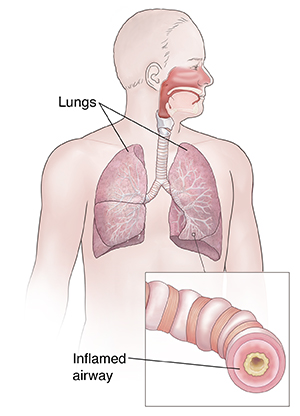Bronchospasm occurs when the airways (bronchial tubes) spasm and contract. This makes breathing hard and causes wheezing (a high-pitched whistling sound). Bronchospasm can also cause frequent coughing without wheezing and feeling short of breath.
Bronchospasm is due to airway irritation, inflammation, or allergic reaction. People with asthma get bronchospasm. However, not everyone with bronchospasm has asthma.
Being exposed to harmful fumes, a recent case of bronchitis, exercise, or a flare-up of chronic obstructive pulmonary disease (COPD) may cause the airways to spasm. An episode of bronchospasm may last 7 to 14 days. Medicine may be prescribed to relax the airways and prevent wheezing. Antibiotics will be prescribed only if your healthcare provider thinks there is a bacterial infection. Antibiotics don't help a viral infection.
Home care
-
Drink lots of water or other fluids (at least 10 glasses a day) during an attack. This will loosen lung secretions and make it easier to breathe. If you have heart or kidney disease, check with your healthcare provider before you drink extra fluids.
-
Take prescribed medicine exactly at the times advised. If you take an inhaled medicine to help with breathing, don't use it more than once every 4 hours unless told to do so. If you are prescribed an antibiotic or steroid medicine, take all the medicine as directed, even if you feel better after a few days.
-
Don't smoke. Also avoid being exposed to secondhand smoke.
-
If you were given a bronchodilator inhaler, use it exactly as directed. It's important to always use the correct techniques. If you need to use it more often than prescribed, your condition may be getting worse. Contact your healthcare provider.
Follow-up care
Follow up with your healthcare provider, or as advised.
If you're age 50 or older, have a chronic lung disease or condition that affects your immune system, or you smoke, ask your provider about the two available pneumococcal vaccines. Ask if one or both of the vaccines are best for you based on your health condition. Also talk with your healthcare provider about the importance of getting a yearly flu shot (influenza vaccine).
When to get medical advice
Call your healthcare provider right away if any of these occur:
-
You need to use your inhalers more often than normal
-
Fever of 100.4°F (38°C) or higher, or as advised by your healthcare provider
-
Cough that brings up lots of dark-colored sputum (mucus)
-
Feeling of doom
-
Feeling dizzy or confused
-
Lips or skin looking blue, purple, or gray
-
You are unable to talk
-
You don't get better in 24 hours
Call 911
Call
-
Coughing up bloody sputum (mucus)
-
Chest pain with each breath, or abnormal chest pain
-
Increased wheezing or shortness of breath


